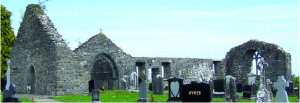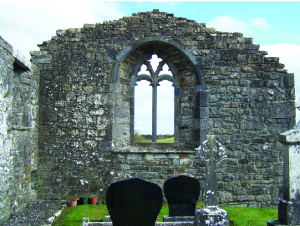Kilcorban friary, Co. Galway
Published in Features, Issue 5 (September/October), Volume 22
Kilcorban friary from the south-west. The west gable is to the left, with the east window to the right.

Carved head, probably of the Virgin Mary, on the south wall of the chapel at Kilcorban friary.
The Dominican Order was founded by St Dominic (c. 1170–1221), who first became an Augustinian canon and subsequently embarked on the foundation of a new religious order in his attempts to deal with the Cathar sect. The Order of Preachers devoted themselves to a life of poverty sustained by begging for alms and undertook an active, preaching-based ministry supported by the lifelong pursuit of learning, intended to augment their preaching. The Dominicans were the first of the mendicant orders to arrive in Ireland, establishing their initial foundations in Dublin and Drogheda in 1224.

Interior of the east gable of Kilcorban friary. The window has been reconstructed but features cusped tracery, triangular stone points used for decorative purposes.
The Dominican Tertiary movement had grown in association with the Dominican First Order. They were formally constituted as an order of penitents in 1284 by Friar Munio of Zamora, master-general of the Dominican Order. As with the Franciscan Third Order, there are two strands of this order: the Third Order Secular, consisting of individuals living in their own homes and following a religious rule, and the Third Order Regular, living a convent-based religious life. The former was intended for people who wished to follow a religious life but whose personal commitments, such as family or work, precluded them from entering a convent. The growth of the Dominican Third Order Secular in the fifteenth century has been attributed to the canonisation in 1461 of St Catherine of Siena (d. 1380), who was a Dominican Tertiary (member of the Third Order). During Catherine’s lifetime, the Dominican Tertiaries were a secular group who had not yet adopted the conventual or regular life. Catherine, for example, spent some years cloistered in her home before deciding to venture out to tend the sick. The Dominican Third Order Regular communities emerged during the fifteenth century in response to a demand from some Tertiaries for the establishment of cloistered communities and became particularly popular in Germany. Although there are gaps in the documentary evidence concerning the Franciscan Third Order Regular in Ireland, their popularity is clearly evident from the number of friaries they established here and the level of patronage this must have entailed, given their alms-dependent lifestyle. In contrast, the Dominican Third Order Regular is poorly attested in Ireland.
The foundation of Kilcorban friary

One of several ledger slabs from Kilcorban friary, featuring a wheel-headed cross with a Calvary base of three steps and decorated with vine-leaves, which have Eucharistic symbolism.
It has been proposed that at the time the land of Kilcorban was granted the Dominican Third Order had not yet become an organised religious order along the lines of the Franciscan Third Order Regular. There has been some confusion as to the affiliation of Kilcorban; for example, in Monasticon Hibernicum Alemand included the friary in a list of ‘Houses of the Third Order of St Francis’. This confusion is perhaps due to the fact that the Dominican Third Order Regular was otherwise unknown in medieval Ireland, in contrast to their very popular Franciscan Tertiary counterparts. It is therefore difficult to gain an insight into the role played by the Dominican Tertiaries. It appears that the Dominican Third Order in Ireland did not embrace the cloistered life as it had on the Continent, but was perhaps more popular as a secular rather than a regular order, with Kilcorban being the notable exception. Certainly, the secular Dominican Tertiaries were widespread in late medieval Ireland, with their presence being attested by documentary sources.
The physical evidence
The surviving remains of Kilcorban friary consist of the east and west gables and the north wall of the church, all part of a simple nave and chancel arrangement, with a chantry chapel to the north. On the south wall of this chapel, facing into the nave, there is a stone carving of a female head, wearing a crown. This may be a depiction of the Virgin Mary, to whom devotion had grown considerably during the late medieval period. Documentary accounts indicate that this church was dedicated to the Blessed Virgin of the Holy Rosary. There is no standing evidence for the presence of domestic buildings, a deficiency this friary shares with many Franciscan Third Order friaries, such as Kilboght, Co. Galway. The possibility that such buildings were constructed of wood should be considered.
Interpretation of the surviving remains of the site would indicate that the Kilcorban community was small to medium in size, in keeping with most communities of the Franciscan Third Order. A selection of late medieval grave-slabs or ledgers survives at the site, providing an insight into the association of patrons with the friary and the services that the friars could provide for their benefactors.
Kilcorban friary had passed into the possession of the Dominican First Order by 1570 but it is not clear when this transfer occurred. The final documentary reference to Tertiaries at the site occurs in 1445, after which the records are silent. Irrespective of the duration of their presence at this site, the Regular Tertiaries of Kilcorban, Co. Galway, provide a significant, though fleeting, glimpse of a way of life that was otherwise unknown in medieval Ireland.
Yvonne McDermott lectures on the Heritage Studies programme in Galway Mayo Institute of Technology, Mayo Campus.
Read More: Early evidence
Further reading
A. Gwynn & R.N. Hadcock, Medieval religious houses: Ireland (Dublin, 1988).
C. Ó Clabaigh, The friars in Ireland, 1224–1540 (Dublin, 2012).
B. O’Sullivan, Medieval Irish Dominican studies (ed. H. Fenning) (Dublin, 2009).
C. Stanley (ed.), Kilcorban Priory (Portumna, 1987).
















